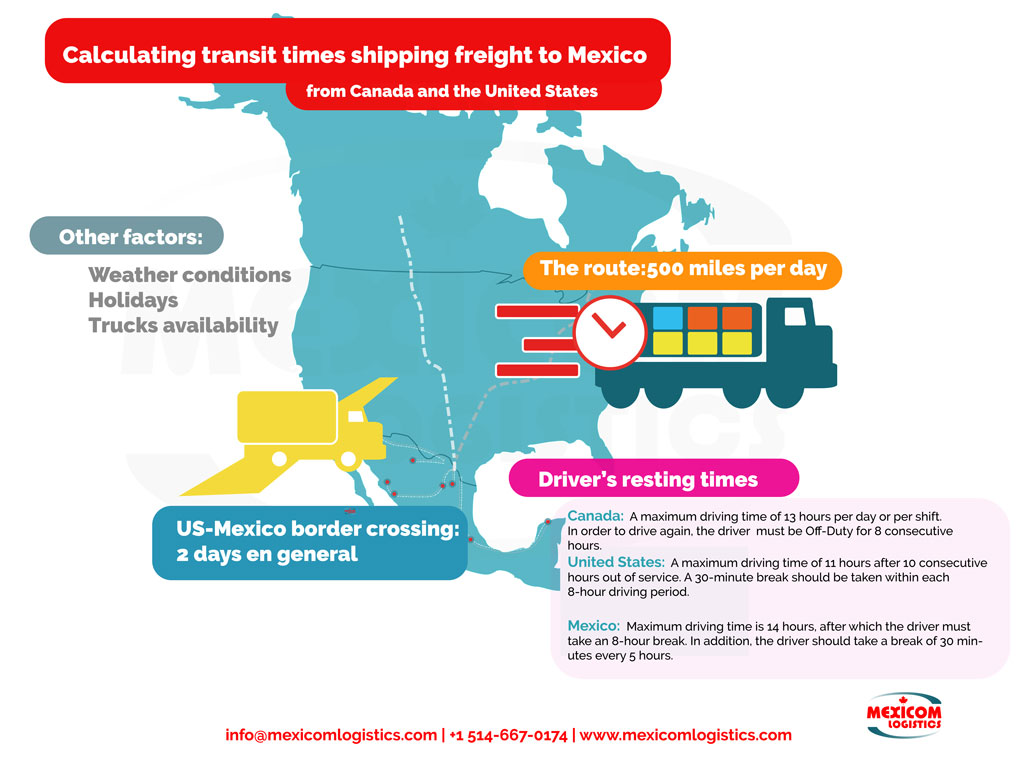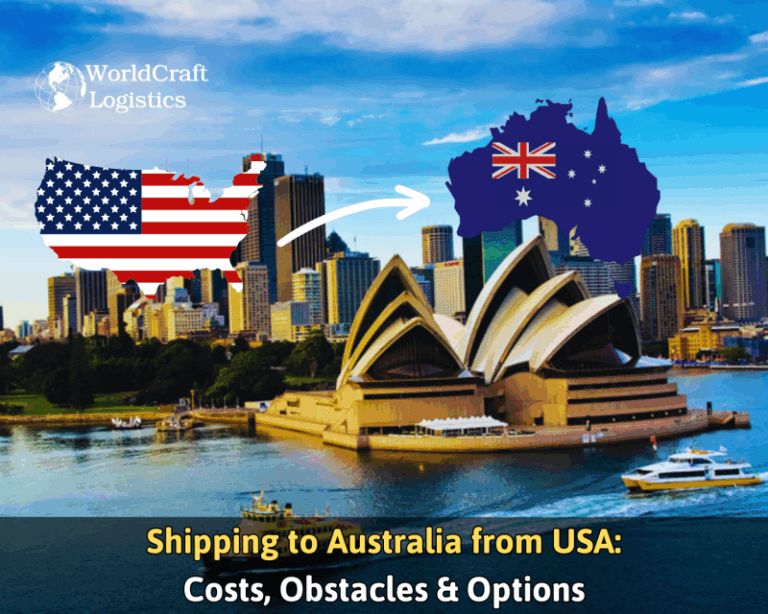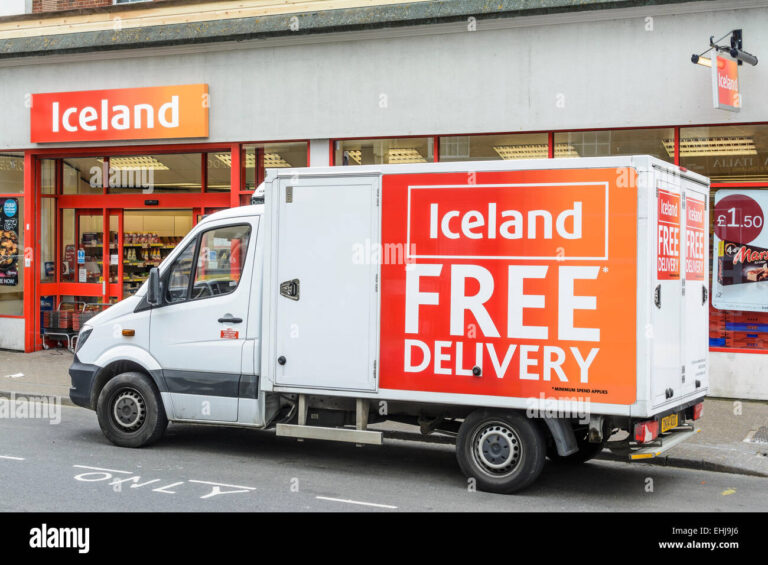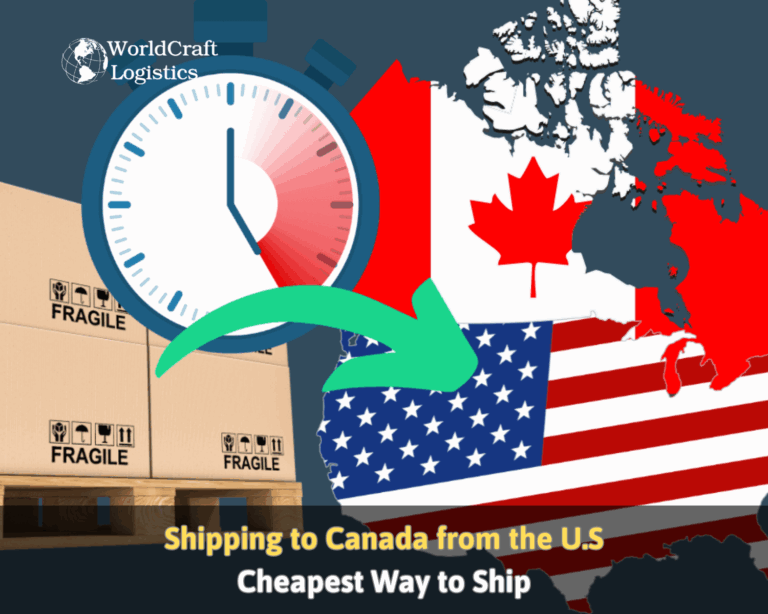Shipping From Mexico To Usa: The Ultimate Guide (2025)
Your Complete Guide to shipping from mexico to usa
Navigating the Complexities of Shipping from Mexico to the USA
In an increasingly interconnected global economy, businesses face numerous challenges when shipping goods across borders. One of the most significant hurdles is navigating the complexities of shipping from Mexico to the United States. With a diverse range of products, fluctuating regulations, and varying shipping methods, international shippers, importers, and exporters often find themselves overwhelmed by the intricacies involved in cross-border logistics. This complexity can lead to delays, unexpected costs, and compliance issues that can affect your bottom line and customer satisfaction.
Understanding the various shipping methods available is crucial for making informed decisions that align with your business needs. From express services to freight shipping, each option presents unique advantages and disadvantages regarding speed, cost, and reliability. Additionally, the costs associated with shipping can vary widely based on factors such as package size, weight, destination, and the chosen shipping provider. Knowing how to estimate these costs and select the most efficient shipping method can save your business time and resources.
Moreover, the transit times for shipments can significantly impact your operations, especially for businesses dealing with time-sensitive goods. By understanding the different service levels offered by various carriers, you can better manage customer expectations and ensure timely delivery.
Customs clearance is another critical aspect of shipping from Mexico to the USA. Each shipment must comply with specific regulations and procedures, and failure to navigate these correctly can lead to costly delays and penalties. This guide will provide you with insights into the customs process, including how to prepare the necessary documentation and what to expect at the border.
Lastly, understanding the potential risks associated with international shipping is vital. From damaged goods to lost shipments, knowing how to mitigate these risks through proper insurance and packaging can protect your business interests.
In this comprehensive guide, you will gain expert knowledge on all aspects of shipping from Mexico to the USA. We will delve into shipping methods, costs, transit times, customs procedures, and risk management strategies. By the end of this guide, you will be equipped with the information needed to navigate the shipping process efficiently, ensuring your goods arrive on time and in compliance with all regulations. Join us on this journey to streamline your shipping operations and enhance your business’s international logistics capabilities.

Table of Contents
- Your Complete Guide to shipping from mexico to usa
- Understanding Your Shipping Options: A Detailed Comparison
- Deconstructing the Cost: A Full Pricing Breakdown
- Transit Time Analysis: How Long Will It Take?
- Navigating Customs Clearance: A Step-by-Step Guide
- A Practical Guide to Choosing Your Freight Forwarder
- Incoterms 2020 Explained for Shippers
- Risk Management: Identifying and Mitigating Common Shipping Problems
- Frequently Asked Questions (FAQs) for shipping from mexico to usa
- Conclusion: Key Takeaways for Successful Shipping
- Important Disclaimer
Understanding Your Shipping Options: A Detailed Comparison
Overview of Shipping Methods from Mexico to the USA
When considering shipping from Mexico to the United States, businesses have several transportation options to choose from, each with its unique advantages and drawbacks. Understanding these options is crucial for optimizing cost, speed, and efficiency in logistics. Below is a comprehensive comparison of the most common shipping methods: Sea Full Container Load (FCL), Sea Less than Container Load (LCL), Air Freight, Rail, and Express Services.
| Shipping Method | Best For | Speed | Cost Level | Key Advantages | Key Disadvantages |
|---|---|---|---|---|---|
| Sea FCL | Large shipments, bulk goods | Slow (2-4 weeks) | Low | Economies of scale, ideal for heavy/bulk shipments | Longer transit times, port fees |
| Sea LCL | Smaller shipments, less than a full container | Moderate (3-6 weeks) | Moderate | Cost-effective for small shipments, no need for full container | Longer transit due to consolidation, risk of damage |
| Air Freight | Urgent shipments, high-value goods | Fast (1-3 days) | High | Quick delivery, reliable for time-sensitive items | Expensive, weight limitations |
| Rail | Heavy freight, bulk goods | Moderate (1-2 weeks) | Moderate | Environmentally friendly, cost-effective for long distances | Limited routes, slower than air freight |
| Express | Time-sensitive shipments, documents | Very fast (same day to 3 days) | High | Fastest option, door-to-door service | High cost, weight and size limitations |
Detailed Breakdown of Each Method
Sea Full Container Load (FCL)
What It Is: FCL shipping involves booking an entire shipping container for your goods. This method is typically used for large shipments that can fill a container.
When to Use It: Opt for FCL when you have enough cargo to fill a full container, which can reduce per-unit shipping costs.
Pros:
– Economies of scale, making it cost-effective for large shipments.
– Less handling of goods, reducing the risk of damage.
– Suitable for bulky and heavy items.
Cons:
– Longer transit times compared to air freight.
– Additional port fees and potential delays at customs.
– Requires careful planning and coordination.
Sea Less than Container Load (LCL)
What It Is: LCL shipping allows multiple shippers to share a single container. This method is ideal for smaller shipments that do not require a full container.
When to Use It: Use LCL for shipments that are less than 10 cubic meters or when you want to avoid paying for a full container.
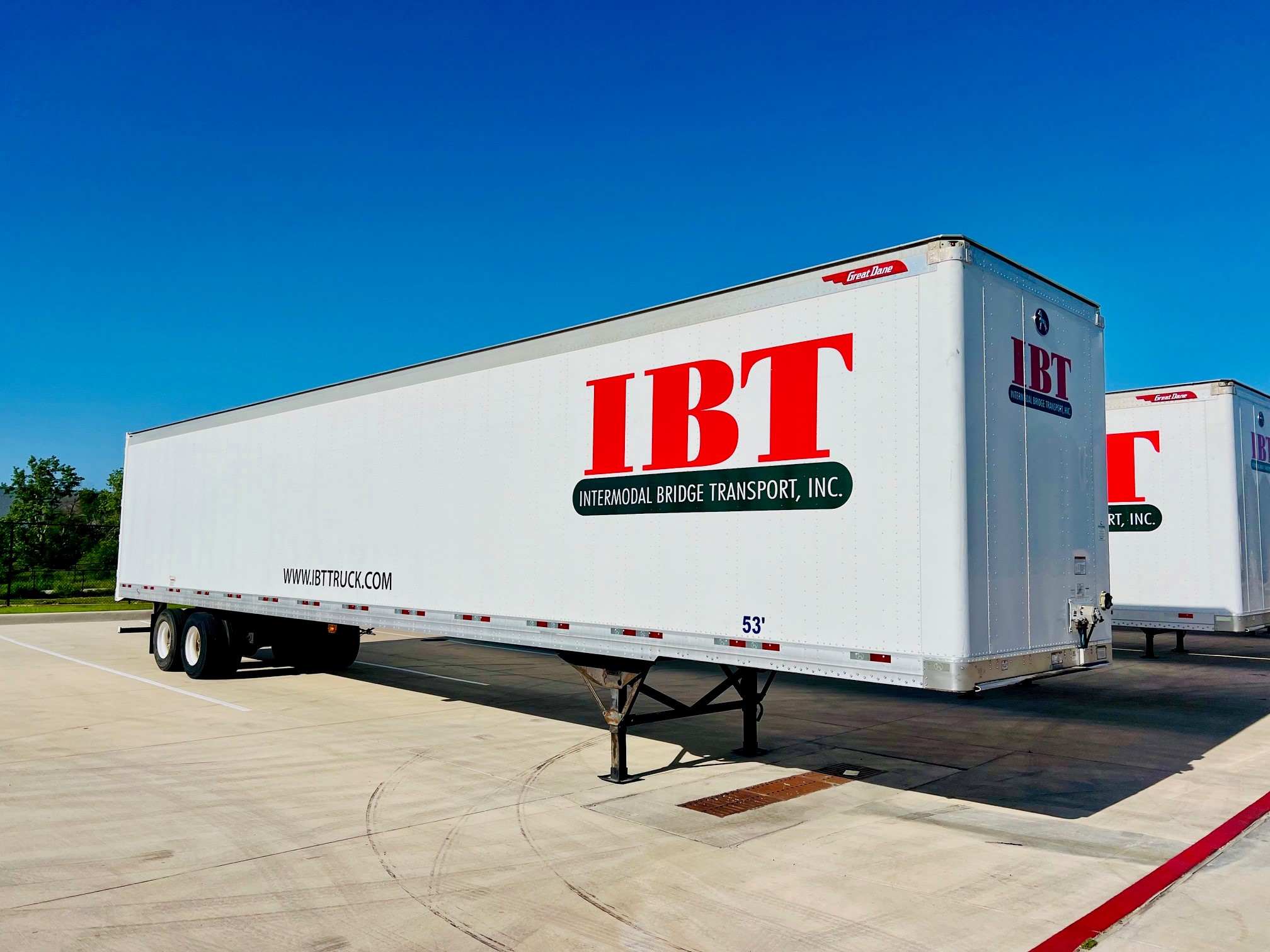
Pros:
– Cost-effective for smaller shipments.
– Flexibility in shipping smaller quantities.
– Reduces storage costs as you only pay for the space you use.
Cons:
– Longer transit times due to consolidation and deconsolidation processes.
– Higher risk of damage due to multiple handling.
– Potential delays in customs clearance.
Air Freight
What It Is: Air freight involves transporting goods via cargo planes. It is the fastest shipping option available.
When to Use It: Choose air freight for urgent shipments or high-value items that need to arrive quickly.
Pros:
– Fastest shipping method, ensuring timely delivery.
– High reliability and reduced risk of theft or damage.
– Suitable for fragile and perishable goods.
Cons:
– Significantly higher costs compared to sea freight.
– Weight limitations can restrict the size of shipments.
– Limited capacity compared to other shipping methods.
Rail
What It Is: Rail freight utilizes train networks to transport goods, primarily used for heavy and bulk cargo.
When to Use It: Use rail for large quantities of goods that are not time-sensitive and can benefit from cost savings.
Pros:
– Cost-effective for bulk shipments over long distances.
– Environmentally friendly with lower carbon emissions.
– Reliable schedules with fewer delays compared to road transport.
Cons:
– Limited access to rail terminals may require additional transportation.
– Slower than air freight, making it less ideal for urgent shipments.
– Potential delays due to rail congestion.
Express Services
What It Is: Express services, offered by companies like DHL, FedEx, and UPS, provide rapid delivery options with door-to-door service.
When to Use It: Use express services for documents, small packages, or urgent shipments that need immediate attention.
Pros:
– Fastest delivery option available.
– Comprehensive tracking capabilities.
– Convenient pickup and delivery services.
Cons:
– High shipping costs, especially for heavier packages.
– Restrictions on package dimensions and weight.
– Limited to specific service areas.
Special Considerations
Multimodal Transport
Multimodal transport combines multiple modes of transportation, such as sea, rail, and road, to optimize shipping efficiency. This method is particularly useful for larger shipments that require different transport methods to reach their final destination. By leveraging the strengths of each mode, shippers can reduce costs and transit times while ensuring that goods are transported safely.
Specialized Options
- Roll-on/Roll-off (RoRo): This method is ideal for vehicles or machinery. Goods are driven directly onto the ship, making loading and unloading more straightforward and efficient.
- Break Bulk: Suitable for oversized or heavy items that cannot fit into standard containers. Break bulk shipping requires specialized handling and equipment but allows for flexibility in transporting various cargo types.
Conclusion
Choosing the right shipping method from Mexico to the USA depends on several factors, including shipment size, urgency, and budget. Understanding the strengths and weaknesses of each method allows businesses to make informed decisions that enhance their logistics efficiency. By leveraging options such as multimodal transport and specialized services, shippers can tailor their approach to meet specific needs and ensure successful cross-border transactions.
Deconstructing the Cost: A Full Pricing Breakdown
Understanding the Cost Components of Shipping from Mexico to the USA
When it comes to shipping goods from Mexico to the United States, understanding the cost structure is crucial for businesses looking to optimize their logistics budget. The overall shipping costs can be broken down into three primary categories: Main Freight, Origin Charges, and Destination Charges. Each component plays a significant role in determining the final shipping price.
Main Freight
The Main Freight cost refers to the primary expense associated with transporting goods from the point of origin in Mexico to the destination in the USA. This can be further categorized based on the mode of transportation:
-
Sea Freight: Typically used for larger shipments, sea freight costs are calculated based on container size (20ft, 40ft) or Less than Container Load (LCL). Factors influencing sea freight costs include fuel prices, shipping line rates, and seasonal demand fluctuations.
-
Air Freight: More suitable for time-sensitive shipments, air freight costs are usually calculated per kilogram. Influencing factors include the weight and dimensions of the cargo, the distance between the origin and destination, and any applicable fuel surcharges.
Origin Charges
Origin Charges encompass all fees associated with preparing the shipment for departure from Mexico. This includes:
-
Packaging Costs: These vary depending on the type of packaging materials used and the complexity of packing required for the goods.
-
Documentation Fees: Costs for customs paperwork, bills of lading, and other necessary documentation to facilitate cross-border shipping.
-
Handling Fees: Charges for loading the shipment onto the transport vehicle at the origin, which can vary based on the nature of the goods and the handling facilities used.
-
Transport to Port/Airport: This includes the costs associated with transporting goods from the point of origin to the nearest shipping port or airport.
Destination Charges
Once the shipment arrives in the USA, Destination Charges come into play. These costs include:
-
Customs Duties and Taxes: These are government-imposed fees that vary based on the type of goods, their declared value, and the applicable trade agreements (e.g., USMCA). Businesses should be aware of the classification codes that determine duty rates.
-
Unloading Fees: Charges incurred for unloading the cargo at the destination port or airport. The complexity and type of cargo can influence these fees.
-
Delivery Charges: Costs associated with transporting the goods from the port or airport to the final destination. This can vary significantly based on distance, weight, and the mode of transport used.
Example Pricing Table
The following table provides a sample pricing structure for shipping from Mexico to the USA. Please note that these are estimates and actual prices may vary based on the shipping provider, season, and specific shipment details.
| Freight Type | Size/Weight | Estimated Cost (USD) |
|---|---|---|
| Sea Freight | 20ft Container | $1,200 – $2,500 |
| 40ft Container | $2,500 – $4,500 | |
| Less than Container Load (LCL) | $150 – $300 per cubic meter | |
| Air Freight | Up to 100 kg | $5 – $10 per kg |
| 100 – 500 kg | $4 – $8 per kg | |
| 500 kg and above | $3 – $7 per kg |
Disclaimer: The prices indicated above are estimates and can vary based on multiple factors including shipping providers, specific routes, fuel prices, and additional services requested.
How to Reduce Costs
For businesses looking to minimize their shipping expenses while maintaining efficiency, here are actionable tips:
-
Consolidate Shipments: Combine multiple orders into one shipment to take advantage of bulk shipping rates. This can significantly reduce the cost per unit.
-
Choose the Right Shipping Method: Evaluate the urgency of your shipments. While air freight is faster, sea freight can be more economical for non-urgent shipments.
-
Negotiate Rates with Carriers: Build relationships with shipping providers and negotiate for better rates based on shipping volume and frequency.
-
Optimize Packaging: Use cost-effective and efficient packaging materials to reduce both weight and volume, thereby lowering shipping costs.
-
Stay Informed on Trade Regulations: Understanding customs duties and taxes can help avoid unexpected costs. Use tools like Landed Cost Estimators to anticipate these expenses.
-
Track Shipping Performance: Utilize tracking tools to monitor shipping times and costs. Identifying inefficiencies can help in making informed decisions for future shipments.
-
Leverage Technology: Employ online shipping tools and software to streamline the shipping process, reducing administrative costs and errors.
By comprehensively understanding the cost components and implementing these strategies, businesses can enhance their shipping efficiency and significantly reduce expenses when shipping from Mexico to the USA.
Transit Time Analysis: How Long Will It Take?
Understanding Transit Times for Shipping from Mexico to the USA
When shipping goods from Mexico to the United States, understanding transit times is crucial for effective supply chain management. Various factors influence how long it takes for shipments to reach their destinations. This analysis provides insights into these variables and offers estimated transit times based on different shipping modes.
Factors Influencing Transit Time
-
Shipping Mode: The choice between air freight and sea freight significantly affects transit times. Air freight is generally faster, with delivery times often measured in days, while sea freight can take several weeks depending on the route and port congestion.
-
Port Congestion: Ports can experience congestion due to high volumes of shipments, especially during peak seasons or when unexpected events (like labor strikes or natural disasters) occur. This can delay the processing of cargo and increase overall transit times.
-
Customs Clearance: Customs regulations and processing times can vary widely. Efficient customs clearance is essential to avoid delays. Having all documentation in order and understanding duties and taxes can expedite this process. Incomplete or incorrect paperwork can lead to significant delays.
-
Routes: The specific shipping route taken can also impact transit times. Direct routes are typically quicker, while shipments that require transfers or multiple stops may take longer. Geographic considerations, such as the distance between origin and destination, also play a role.
-
Weather Conditions: Inclement weather can disrupt logistics operations, particularly for air and sea transport. Factors such as storms, hurricanes, or heavy snow can cause delays in shipping schedules and affect transit times.
Estimated Transit Time Table
Here is a table summarizing estimated transit times for various shipping routes from Mexico to the USA:
| Origin | Destination | Sea Freight (Days) | Air Freight (Days) |
|---|---|---|---|
| Mexico City | Los Angeles | 10-15 | 2-3 |
| Guadalajara | Houston | 8-12 | 2-3 |
| Monterrey | Chicago | 12-16 | 2-3 |
| Tijuana | San Diego | 5-7 | 1-2 |
| Veracruz | Miami | 10-14 | 3-4 |
| Cancún | Orlando | 12-16 | 3-4 |
Context and Explanation
The transit time estimates provided in the table are port-to-port times. This means that the figures represent the duration it takes for a shipment to travel from the departure port in Mexico to the arrival port in the USA, excluding any additional time needed for customs clearance, local delivery, or handling at the destination.
When planning shipments, businesses should consider these factors and build in extra time for potential delays. For example, while air freight is faster, unexpected customs issues can still lead to delays. Similarly, sea freight, despite being more economical, requires careful planning for longer transit times and potential port congestion.
To mitigate risks and ensure timely delivery, shippers are encouraged to:
– Monitor Shipping Status: Utilize tracking tools offered by logistics providers to stay informed about shipment status.
– Prepare Documentation: Ensure all necessary customs documentation is complete and accurate to prevent delays.
– Plan for Contingencies: Allow for buffer time in supply chain schedules to accommodate any unforeseen delays.
By understanding these dynamics and preparing accordingly, businesses can optimize their shipping operations from Mexico to the USA, ensuring a smoother and more predictable transit process.
Navigating Customs Clearance: A Step-by-Step Guide
The Process Explained
Navigating customs clearance when shipping from Mexico to the USA can seem daunting, but understanding the workflow can simplify the process significantly. Here’s a step-by-step guide to help you through:
- Pre-Shipping Preparation:
-
Before you ship, ensure that you have a clear understanding of the products being shipped, their destination, and the regulations that apply. Research the specific requirements for your goods, including any restrictions or prohibitions.
-
Gather Required Documentation:
-
Compile all necessary documents that will accompany your shipment. This documentation is crucial for smooth customs clearance. Ensure that each document is accurate and complete to avoid delays.
-
Submit Customs Declaration:
-
Complete the customs declaration form accurately, detailing the contents of your shipment. This form will be submitted to U.S. Customs and Border Protection (CBP) upon arrival at the border.
-
Pay Applicable Duties and Taxes:
-
Calculate and pay any duties and taxes that may apply to your shipment based on its declared value and classification. Understanding the Harmonized System (HS) codes for your goods will help in this process.
-
Customs Inspection:
-
Upon arrival in the U.S., your shipment may be subject to inspection by customs officials. They will verify the contents against the submitted documentation and assess compliance with U.S. regulations.
-
Release of Goods:
-
If everything is in order, customs will release your shipment for delivery. You will receive notification of this release, allowing you to arrange for the final leg of transportation to your destination.
-
Post-Shipping Compliance:
- After your shipment has cleared customs, it’s vital to maintain records of the transaction, including all documentation. This is important for future reference and may be required for audits by customs authorities.
Essential Documentation
Proper documentation is the backbone of successful customs clearance. Here’s a list of essential documents you will need:
- Commercial Invoice:
-
This document provides a detailed account of the goods being shipped, including the price, quantity, and terms of sale. It serves as a primary document for customs clearance.
-
Packing List:
-
A packing list outlines the contents of each package in the shipment. This document should detail the dimensions, weight, and description of the items, helping customs officials verify the shipment.
-
Bill of Lading:
-
This is a contract between the shipper and the carrier that outlines the specifics of the shipment, including the type of goods, destination, and terms of transport. It serves as proof of shipment.
-
Customs Declaration Form:
-
This form is required by U.S. Customs and Border Protection to declare the goods being imported. It includes information about the shipper, consignee, and the nature of the goods.
-
HS Code Documentation:
- Each product must be classified under a specific Harmonized System (HS) code. This code determines the duty rates applicable to your shipment and must be included in the customs declaration.
Duties, Taxes, and HS Codes
Understanding duties, taxes, and HS codes is essential for calculating the total cost of your shipment.
- Harmonized System (HS) Codes:
-
HS codes are standardized numerical codes used internationally to classify goods for customs purposes. Each code corresponds to a specific product, which helps determine the applicable duties and taxes.
-
Duties and Taxes Calculation:
- Duties and taxes are calculated based on the declared value of the goods and their HS code classification. The U.S. Customs and Border Protection uses these codes to assess the proper duty rate. Factors affecting the calculation include:
- Value of Goods: The total price paid or payable for the items.
- Country of Origin: The country where the goods were manufactured or produced.
- Type of Goods: Certain products may be subject to specific tariffs or exemptions.
Common Problems & Solutions
Even with thorough preparation, issues can arise during customs clearance. Here are some common problems and their solutions:
- Incomplete Documentation:
- Problem: Missing or incorrect documents can lead to delays or fines.
-
Solution: Double-check all paperwork before shipping. Use a checklist to ensure you have all required documents and that they are accurate.
-
Incorrect HS Code Classification:
- Problem: Misclassifying goods can result in higher duties or penalties.
-
Solution: Research HS codes thoroughly or consult with a customs broker to ensure accurate classification.
-
Undeclared or Under-declared Value:
- Problem: Declaring a lower value to reduce duties can lead to severe penalties.
-
Solution: Always declare the true value of your goods. Transparency is key to avoiding legal issues.
-
Inadequate Packaging:
- Problem: Poor packaging can lead to damage or loss during transit, complicating claims with customs.
-
Solution: Use proper packaging materials and techniques. Ensure that items are securely packed and protected.
-
Failure to Pay Duties on Time:
- Problem: Not paying duties promptly can result in your shipment being held or returned.
- Solution: Understand the payment timelines and ensure funds are available to cover any duties or taxes.
Conclusion
Navigating customs clearance when shipping from Mexico to the USA involves careful planning and attention to detail. By understanding the process, preparing the necessary documentation, and being aware of potential pitfalls, businesses can facilitate smoother transactions and ensure compliance with regulations. Always consider consulting with logistics professionals or customs brokers to streamline the process and mitigate risks associated with international shipping.
A Practical Guide to Choosing Your Freight Forwarder
Understanding the Importance of Selecting the Right Freight Forwarder
When shipping goods from Mexico to the USA, choosing the right freight forwarder is crucial for ensuring a seamless logistics experience. A reliable partner can help navigate customs regulations, optimize shipping costs, and provide timely deliveries. This guide outlines the key qualities to look for in a freight forwarder, offers a sourcing checklist, and highlights potential red flags to be aware of during your selection process.
Key Qualities to Look for in a Freight Forwarder
-
Experience and Expertise
A freight forwarder with a proven track record in international shipping, particularly between Mexico and the USA, can significantly reduce the risk of delays and complications. Their familiarity with the customs processes, documentation requirements, and local regulations will ensure your shipments are compliant and efficient. -
Extensive Network
The freight forwarder should have a robust network of carriers, customs brokers, and warehouses. This network enables them to offer various shipping options, including air, sea, and land transport, and provides flexibility in addressing unexpected challenges. -
Licensing and Certification
Verify that the freight forwarder is licensed and certified to operate in both Mexico and the USA. This includes compliance with local laws, as well as international regulations, such as those set by the Federal Maritime Commission (FMC) or the International Air Transport Association (IATA). -
Strong Communication Skills
Effective communication is vital in logistics. The freight forwarder should be responsive and provide clear, timely updates regarding your shipment’s status. They should also be able to explain complex logistics terms and processes in a way that is easily understandable. -
Technology and Tracking Capabilities
A modern freight forwarder should offer technology solutions that provide visibility into your shipments. Look for platforms that allow you to track your cargo in real-time and access important documents electronically, making the process more efficient. -
Customer Service and Support
Exceptional customer service should be a cornerstone of your freight forwarder’s operations. They should provide dedicated support, whether through a customer service hotline, email, or online chat, to address your queries and concerns promptly.
Sourcing Checklist for Selecting a Freight Forwarder
Follow these action steps to ensure you choose the right freight forwarder for your shipping needs:
-
Define Your Shipping Needs
Assess your specific requirements, including shipment size, frequency, destination, and any special handling requirements. -
Research Potential Forwarders
Look for freight forwarders with a solid reputation in the industry. Check online reviews, seek recommendations from peers, and consider their experience with shipping from Mexico to the USA. -
Request Quotes
Reach out to multiple freight forwarders to obtain quotes. Ensure that each quote includes a breakdown of costs, transit times, and service levels to make comparisons easier. -
Ask Questions
Engage with potential forwarders and ask about their processes, technology, customs handling, and contingency plans for delays or issues. This will give you insight into their capabilities and reliability. -
Check References
Request references from past clients and follow up to gauge their satisfaction with the services provided. Pay attention to feedback regarding reliability, communication, and problem-solving abilities.
Red Flags to Watch Out For
When evaluating freight forwarders, be mindful of these warning signs that could indicate potential problems:
-
Lack of Transparency
If a forwarder is reluctant to provide detailed information about their services, pricing, or processes, it may signal underlying issues. -
Limited Experience
A freight forwarder with little to no experience in shipping from Mexico to the USA may struggle with the complexities of customs regulations and logistics. -
Poor Communication
Delayed responses or unprofessional communication can be a red flag. A reliable forwarder should be accessible and responsive to your inquiries. -
Hidden Fees
Be cautious of quotes that seem too good to be true. Ensure that the pricing includes all potential fees, and ask for clarification on any vague terms. -
Negative Reviews
Consistently poor reviews or unresolved complaints on platforms like Google or industry-specific forums can indicate a lack of reliability.
Conclusion
Selecting the right freight forwarder for shipping from Mexico to the USA is a critical decision that can impact your business’s efficiency and bottom line. By considering the essential qualities outlined above, following the sourcing checklist, and being aware of potential red flags, you can make an informed choice that aligns with your shipping needs. A reliable freight forwarder will not only facilitate smooth logistics but also serve as a valuable partner in your international trade endeavors.
Incoterms 2020 Explained for Shippers
Understanding Incoterms: A Brief Overview
Incoterms, or International Commercial Terms, are standardized trade terms published by the International Chamber of Commerce (ICC). They are used in international contracts to define the responsibilities of buyers and sellers regarding the delivery of goods. By clarifying the obligations and risks associated with shipping, Incoterms help facilitate smooth transactions and minimize disputes in international trade. For shippers involved in transporting goods from Mexico to the United States, understanding these terms is crucial for effective logistics management and compliance with regulations.
Key Incoterms Table
| Incoterm | Who Pays for Transport? | Where Risk Transfers? | Best for |
|---|---|---|---|
| EXW | Buyer | Seller’s premises | Buyers who want maximum control |
| FOB | Seller | Ship’s rail | Sellers who handle logistics up to the port |
| CIF | Seller | Port of destination | Buyers who want a more hands-off approach |
| DDP | Seller | Destination address | Buyers wanting full control with minimal hassle |
Detailed Explanation of Common Incoterms
EXW (Ex Works)
Under the EXW Incoterm, the seller makes the goods available at their premises or another named place (e.g., factory, warehouse). The buyer is responsible for all transportation costs and risks from that point onward. This term is ideal for buyers who prefer to control the entire shipping process. For instance, if a company in Germany purchases machinery from a manufacturer in Mexico, the German company will handle all aspects of shipping, including export clearance and transport to their facility.
FOB (Free On Board)
FOB indicates that the seller is responsible for transporting the goods to a specified port and loading them onto the vessel. Once the goods are on board, the risk transfers to the buyer. This term is commonly used in maritime shipping and is particularly favorable for sellers who wish to manage logistics up to the point of shipment. For example, if a Mexican textile manufacturer ships goods to a U.S. importer under FOB terms, the manufacturer will cover costs and risks until the goods are loaded on the ship at the port in Mexico.
CIF (Cost, Insurance, and Freight)
CIF requires the seller to cover the cost of transport, insurance, and freight until the goods reach the specified port of destination. The risk transfers to the buyer as soon as the goods are loaded onto the vessel. This term is advantageous for buyers who prefer a less hands-on approach but still want assurance regarding the goods’ transport. For instance, a company in the UAE purchasing electronics from Mexico may choose CIF terms, enabling them to rely on the seller for safe delivery and insurance during transit to the UAE.
DDP (Delivered Duty Paid)
DDP places the maximum responsibility on the seller, who is liable for all costs and risks associated with transporting the goods to the buyer’s specified location, including duties and taxes. This term is ideal for buyers who want a hassle-free experience, as the seller manages all logistics. For example, a U.S. business importing specialty food products from Mexico under DDP terms would have the seller handle everything from export clearance in Mexico to import duties upon arrival in the U.S., ensuring a smooth transaction.
Conclusion
Understanding Incoterms is essential for international shippers and businesses engaged in trade between Mexico and the U.S. By clearly defining responsibilities related to transportation, risk, and costs, these terms facilitate smoother transactions, reduce the likelihood of disputes, and enable shippers to optimize their logistics strategies. Whether you are a buyer or seller, choosing the appropriate Incoterm can significantly impact the efficiency and cost-effectiveness of your shipping operations.
Risk Management: Identifying and Mitigating Common Shipping Problems
Importance of Proactive Risk Management
In the realm of international shipping, particularly between Mexico and the USA, proactive risk management is not just a best practice; it’s a necessity. The complexities of cross-border logistics—ranging from customs regulations to varying transportation conditions—can lead to significant disruptions if not properly managed. Proactive risk management allows businesses to identify potential challenges before they escalate into costly problems, ensuring smoother operations, improved customer satisfaction, and enhanced financial performance. By implementing effective risk management strategies, businesses can navigate the intricacies of shipping with greater confidence and resilience.
Risk Analysis Table
| Potential Risk | Impact | Mitigation Strategy |
|---|---|---|
| Cargo Damage | Financial loss, customer dissatisfaction | Use high-quality packaging materials, train staff on handling procedures, and conduct regular inspections. Consider cargo insurance for added protection. |
| Delays | Impact on supply chain, increased costs | Build buffer times into shipping schedules, choose reliable carriers, and monitor weather and traffic conditions. Implement real-time tracking systems to stay informed. |
| Customs Holds | Shipment delays, potential fines | Ensure all documentation is complete and accurate before shipping. Work with customs brokers to navigate regulations effectively. Stay updated on trade agreements and tariffs. |
| Regulatory Changes | Compliance issues, fines | Regularly review shipping regulations and engage with legal experts. Subscribe to industry updates for timely information on changes in trade policies. |
| Theft or Loss | Financial loss, reputational damage | Utilize GPS tracking for high-value shipments, employ security measures during transportation, and ensure adequate insurance coverage. Conduct background checks on freight partners. |
| Natural Disasters | Shipment disruptions, potential loss | Diversify shipping routes and methods. Have contingency plans in place, including alternative carriers and warehouses. Regularly assess risk factors in shipping routes. |
Cargo Insurance Explained
Cargo insurance is a critical component of risk management in international shipping. It provides financial protection against various risks that may lead to the loss or damage of goods during transit. Understanding the types of cargo insurance available and its coverage is essential for businesses shipping from Mexico to the USA.
What It Covers
Cargo insurance typically covers:
- Physical Damage: Protection against damage caused by accidents, mishandling, or natural disasters.
- Theft and Loss: Compensation for goods that are lost or stolen during transit.
- Delay Coverage: Some policies include coverage for financial losses incurred due to delays in delivery.
- Contingency Coverage: This can cover unforeseen events that may not be explicitly listed in standard policies, providing broader protection.
Types of Cargo Insurance
- All-Risk Coverage: This comprehensive policy covers a wide range of potential risks, including damage and theft, except for specific exclusions.
- Named Perils Coverage: This type only covers risks explicitly listed in the policy, such as fire, collision, or theft. It’s generally less expensive but offers limited protection.
- General Average: In maritime shipping, if a ship’s cargo is jettisoned to save the vessel, this coverage helps share the loss among all parties involved.
Why It’s Essential
Investing in cargo insurance is essential for several reasons:
- Financial Security: It mitigates the financial impact of unforeseen events, allowing businesses to recover losses without crippling their finances.
- Peace of Mind: Knowing that shipments are insured provides confidence to businesses, allowing them to focus on growth rather than worrying about potential losses.
- Customer Trust: Offering insured shipments can enhance customer satisfaction, as clients feel more secure knowing their goods are protected.
- Compliance: In certain industries, having cargo insurance may be a regulatory requirement, ensuring that businesses adhere to legal standards.
Conclusion
In summary, effective risk management is vital for successful shipping from Mexico to the USA. By identifying potential risks and implementing mitigation strategies, businesses can protect their interests, ensure compliance, and maintain a competitive edge in the market. Additionally, investing in cargo insurance is a prudent step that provides essential protection and peace of mind in the unpredictable landscape of international logistics. By prioritizing risk management, businesses can not only safeguard their operations but also enhance their reputation and customer relationships.
Frequently Asked Questions (FAQs) for shipping from mexico to usa
1. What are the key shipping options available for sending goods from Mexico to the USA?
There are several shipping options available for transporting goods from Mexico to the USA, including express services, freight shipping, and standard parcel delivery. Major carriers like DHL, FedEx, and UPS offer tailored solutions for different business needs, ranging from time-sensitive deliveries to cost-effective bulk shipping.
2. How are shipping costs calculated for shipments from Mexico to the USA?
Shipping costs depend on various factors, including the weight and dimensions of the package, the destination, the selected shipping service (express vs. standard), and any additional services requested, such as insurance or tracking. Each carrier provides online tools to estimate shipping costs based on these parameters.
3. What is chargeable weight and how is it determined?
Chargeable weight is a billing measurement used by shipping companies to calculate shipping costs. It is based on either the actual weight or the dimensional weight (volumetric weight) of the package, whichever is greater. Dimensional weight is calculated by multiplying the package’s dimensions (length x width x height) and then dividing by a specific dimensional factor set by the carrier.
4. What customs documentation is required for shipping from Mexico to the USA?
To ensure smooth customs clearance, shippers must provide specific documentation, including a commercial invoice, a bill of lading (BOL) or air waybill (AWB), and, in some cases, a customs bond. The commercial invoice details the contents and value of the shipment, while the BOL or AWB serves as a contract between the shipper and carrier.
5. What is the difference between a Bill of Lading (BOL) and an Air Waybill (AWB)?
A Bill of Lading (BOL) is used for ground transport and serves as a receipt for the goods and a contract for transportation. In contrast, an Air Waybill (AWB) is specific to air freight and serves a similar purpose but is designed for air cargo services. Both documents are essential for tracking and managing shipments.
6. How long does shipping typically take from Mexico to the USA?
Shipping times vary based on the service selected. Express shipping options can deliver packages within 1-3 business days, while standard shipping may take 5-7 business days or longer. Factors such as customs processing and the specific destination within the USA can also affect delivery times.
7. Are there any restrictions on items that can be shipped from Mexico to the USA?
Yes, certain items are restricted or prohibited from entering the USA. This includes hazardous materials, perishables, counterfeit goods, and specific electronics. It’s crucial to check the latest customs regulations and restrictions to avoid complications during shipping.
8. How can I track my shipment from Mexico to the USA?
Most major carriers offer online tracking systems where you can monitor the status of your shipment using the tracking number provided upon booking. Carriers like DHL, FedEx, and UPS have user-friendly websites and mobile apps for real-time tracking updates.
9. What are customs duties and how are they calculated for shipments to the USA?
Customs duties are tariffs imposed on imported goods, calculated based on the item’s declared value, classification, and origin. The Harmonized Tariff Schedule (HTS) is used to determine the duty rate for specific items. Importers should be aware of any applicable tariffs to estimate total shipping costs accurately.
10. What is a customs bond, and do I need one for shipping from Mexico to the USA?
A customs bond is a contract between the importer, the surety company, and U.S. Customs and Border Protection (CBP) that guarantees the payment of duties and compliance with customs regulations. Businesses importing goods over a certain value may be required to obtain a customs bond to facilitate the shipping process and ensure compliance with U.S. laws.
Conclusion: Key Takeaways for Successful Shipping
Effective Strategies for Shipping from Mexico to the USA
Successfully navigating the shipping landscape from Mexico to the United States involves a combination of strategic planning, choosing the right partners, and understanding the cost implications. Here are the key takeaways for a smooth shipping experience:
Planning is Essential
Before shipping, it’s crucial to assess your needs carefully. Determine the type of goods you are shipping, their value, and the urgency of delivery. This evaluation helps in selecting the most suitable shipping method—whether express or standard. Understanding customs regulations and documentation requirements is also vital to ensure that your shipments cross the border without delays. Utilize tools like duty calculators and landed cost estimators offered by logistics providers to gain insights into potential costs and regulations.
Choose the Right Shipping Partners
Selecting a reliable logistics partner can significantly impact the efficiency of your shipping operations. Companies like DHL, FedEx, and UPS offer a range of services tailored for international shipping. Evaluate their offerings based on delivery speed, service coverage, and customer support. An experienced partner can provide invaluable guidance through the complexities of customs processes and help you navigate any potential challenges.
Understand Costs and Budget Accordingly
Shipping costs from Mexico to the USA can vary widely based on factors such as package weight, dimensions, service type, and destination. Be proactive in obtaining quotes from multiple carriers to find the best deal. Additionally, consider the implications of duties and taxes, which can affect your overall budget. Having a clear understanding of these costs upfront will help you make informed decisions and avoid unexpected expenses.
Take Action for Success
In conclusion, the key to successful shipping from Mexico to the USA lies in thorough planning, choosing the right logistics partners, and being aware of all associated costs. As you embark on your shipping journey, leverage the expertise of leading logistics providers and utilize their tools to streamline the process. Start today to enhance your shipping strategy, optimize your operations, and ensure that your goods reach their destination efficiently. Don’t hesitate to reach out to logistics experts for tailored solutions that fit your business needs!
Important Disclaimer
⚠️ Important Disclaimer
The information in this guide is for educational purposes only and does not constitute professional logistics advice. Rates, times, and regulations change frequently. Always consult with a qualified freight forwarder for your specific needs.
